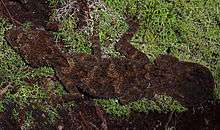Southern Leaf-tailed Gecko
| Southern leaf-tailed gecko | |
|---|---|
 | |
| Not evaluated (IUCN 3.1) | |
| Scientific classification | |
| Kingdom: | Animalia |
| Phylum: | Chordata |
| Class: | Reptilia |
| Order: | Squamata |
| Suborder: | Scleroglossa |
| Infraorder: | Gekkota |
| Family: | Carphodactylidae |
| Subfamily: | Diplodactylinae |
| Genus: | Saltuarius |
| Species: | S. swaini |
| Binomial name | |
| Saltuarius swaini White, 1790 | |
The southern leaf-tailed gecko has two species. One, Saltuarius wyberba, lives in the granite belt of northern New South Wales and southern Queensland, Australia. They do their foraging at night on massive rock faces. They have been observed active at temperatures colder than −10°C.
The other species, Saltuarius swaini, inhabits rainforests and lives inside large tree root systems and hollows of strangler figs.
Camouflage
When threatened or caught geckos can drop their tail to confuse predators. Eventually a new tail will be regenerated, although only the original tail will have the tubercules and matching colour and pattern to the torso; new tails will be very different in both colour and pattern. Southern leaf tailed geckos are a light to dark brown colour with darker patterns.
Life cycle
Female southern leaf-tailed geckos usually lay one or two soft-shelled eggs in late spring. These eggs are up to 28 mm in length. The eggs are buried in moist soil or leaf litter to prevent their drying out. Left to develop unattended, 3 months later the offspring hatch and begin fending for themselves, catching insects within only a few days of birth. They take up to two years to fully mature and then can survive for up to eight more years.
Diet
The southern leaf-tailed gecko eats mostly insects.
External links
| Wikispecies has information related to: Saltuarius swaini |
| Wikimedia Commons has media related to Saltuarius swaini. |